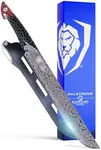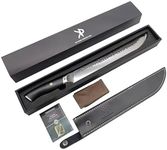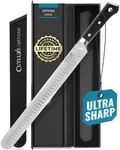Buying Guide for the Best Meat Knife For Brisket
Choosing the right meat knife for brisket is essential for achieving the perfect slice and ensuring a great culinary experience. A good brisket knife will help you cut through the meat smoothly and evenly, preserving the texture and flavor. When selecting a knife, consider the key specifications that will best suit your needs and preferences.Blade LengthBlade length is the measurement of the cutting edge of the knife. For brisket, a longer blade is generally preferred because it allows for smoother, more even cuts. Blades typically range from 8 to 14 inches. A blade around 12 inches is often ideal for brisket as it provides enough length to cut through large pieces of meat in one motion, reducing the need for sawing back and forth which can tear the meat. If you frequently cook large briskets, opt for a longer blade. For smaller cuts or if you have limited storage space, a shorter blade might be more practical.
Blade MaterialThe material of the blade affects its sharpness, durability, and ease of maintenance. Common materials include stainless steel, high-carbon steel, and ceramic. Stainless steel is resistant to rust and easy to maintain, making it a popular choice for many. High-carbon steel is known for its sharpness and edge retention but requires more care to prevent rust. Ceramic blades are extremely sharp and lightweight but can be brittle and prone to chipping. Choose a blade material based on your willingness to maintain the knife and your preference for sharpness and durability.
Blade FlexibilityBlade flexibility refers to how much the blade can bend without breaking. A more flexible blade can be useful for trimming fat and making precise cuts, while a stiffer blade provides more control and power for slicing through thick meat. For brisket, a semi-flexible blade is often ideal as it offers a good balance between precision and control. If you prefer more control and less bending, go for a stiffer blade. If you need to make more intricate cuts, a more flexible blade might be better.
Blade EdgeThe edge of the blade can be straight, serrated, or granton (scalloped). A straight edge is versatile and provides clean cuts, making it suitable for most brisket slicing tasks. A serrated edge can be useful for cutting through crusty exteriors but may tear the meat. A granton edge has small indentations that create air pockets, reducing friction and preventing the meat from sticking to the blade. For brisket, a straight or granton edge is usually preferred. Choose a straight edge for general use and a granton edge if you want smoother, cleaner cuts with less sticking.
Handle ComfortThe handle of the knife should be comfortable to hold and provide a secure grip. Handles can be made from various materials such as wood, plastic, or composite. Wood handles offer a traditional look and feel but may require more maintenance. Plastic handles are durable and easy to clean but may not provide the same level of comfort. Composite handles combine the benefits of both wood and plastic, offering durability and comfort. When choosing a handle, consider the ergonomics and how it feels in your hand. A comfortable, non-slip grip is essential for safe and efficient cutting.
Weight and BalanceThe weight and balance of the knife affect how it feels and performs during use. A well-balanced knife will feel comfortable and stable in your hand, making it easier to control. Heavier knives can provide more power for cutting through thick meat, while lighter knives are easier to maneuver for precise cuts. For brisket, a knife with a good balance between the blade and handle is ideal. Test the knife by holding it and making a few cutting motions to see how it feels. Choose a weight and balance that feels comfortable and suits your cutting style.


















